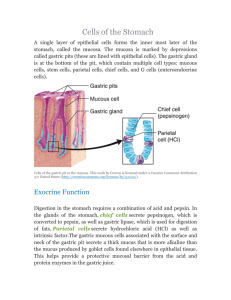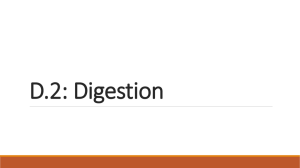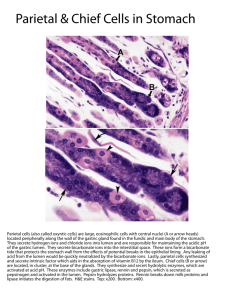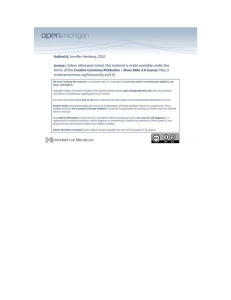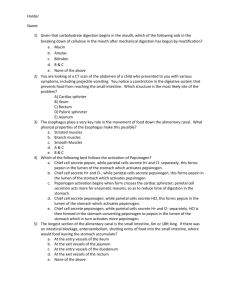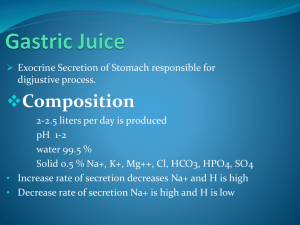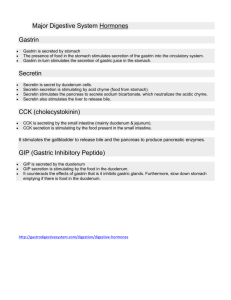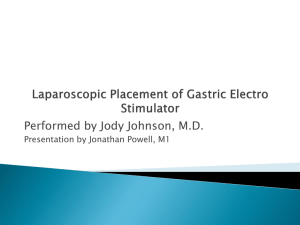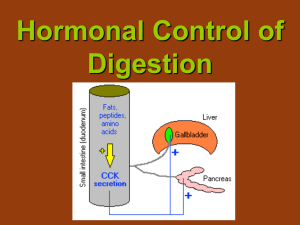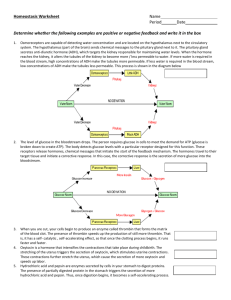Digestion in the stomach
advertisement
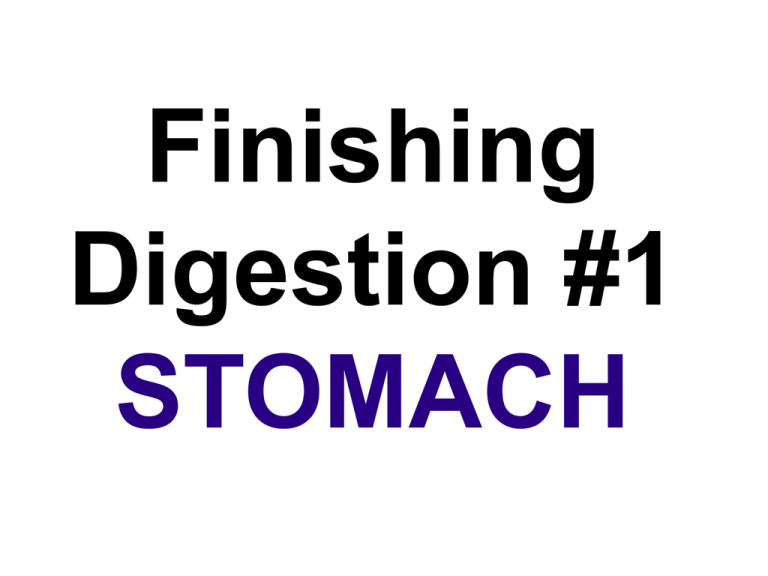
Finishing Digestion #1 STOMACH Rumen: softens food. Reticulum: more softening into cud. Omasum: digestion. Abomasum: more digestion! 1 Rumen 2 Reticulum Intestine Esophagus 4 Abomasum 3 Omasum • A J-shaped organ with walls made of three smooth muscle layers, epithelial tissue and connective tissue. • Entrance through the lower esophageal sphincter, exit through the pyloric sphincter. • The stomach is a muscular bag which stores food and secretes gastric juice, which converts the bolus into acidic chyme. • Can expand when full or contract when empty, resulting in rugae, or wrinkles forming. Esophagus 5 µm Lower esophageal sphincter Stomach Pyloric sphincter Rugae Interior surface of stomach Duodenum (Small intestine) • The left & right gastric arteries supply the stomach with fresh blood. • Stomach is drained by the left & right gastric veins which link to the hepatic portal vein. A mucosa layer of epithelial tissue containing gastric glands in gastric pits. These glands secrete acid, hormones and enzymes. Three muscle layers (oblique, circular & longitudinal layers) aid in churning of food. An external serosa layer of connective tissue for strength & flexibility. • Gastric pits in the inner epithelium lead to gastric glands. • Endocrine cells: secrete the hormone gastrin, which turns on the whole stomach (seen later). • Parietal cells: secrete HCI, an acid capable of denaturing proteins, killing germs and breaking down plant cell walls. • Chief cells: secrete pepsin, (or pepsinogen), the main protease (protein-digesting enzyme) found in the stomach. Also secrete some gastric lipase, which begins lipid digestion. • Mucus cells: secrete protective mucus. • The stomach wall is lined by exocrine glands that house the various types of cells responsible for secreting gastric juice (HCI acid, pepsin), and mucus. Interior surface of stomach Epithelium 3 Pepsinogen 2 1 H+ Cl– Chief cells secrete pepsinogen Parietal cells secrete HCI acid. 1 Pepsinogen and HCl are secreted. HCl Gastric gland Mucus cells secrete protective mucus Pepsin 2 HCl converts pepsinogen to pepsin. 3 Pepsin activates more pepsinogen. Chief cell Parietal cell G cells Secrete Gastrin PROTEIN STRUCTURE • The amino acid sequence makes up a protein’s primary structure. • Successive folding results in the formation of the secondary & tertiary structures. • If two or more tertiary structure proteins bind together a quaternary structure protein forms. • HCI will destroy the 2ry, 3ry &4ry structures, unfolding the protein. • Proteases will digest the 1ry structure into small peptides or individual amino acids. Control of the stomach • Three phases are involved: – Cephalic phase prepares the stomach to receive food. – Gastric phase begins when food enters the stomach. – Intestinal phase controls the emptying of the stomach into the duodenum. • Sight, smell, taste or thoughts of food stimulate the CNS. The vagus nerve stimulates endocrine, mucus, chief and parietal cells. • Gastrin is released into the blood... • Gastrin stimulates the release of more HCI and pepsin. • Low, acidic pH and stretching of the stomach wall stimulate “mixing waves” of contracting smooth muscle. • In response to acidic pH, duodenum secretes secretin, which inhibits G-cells & parietal cells. Also stimulates pancreas to produce buffers. • Duodenum also secretes the hormone cholecystokinin (CKK), which also inhibits the G-cells and encourages the liver and pancreas to release enzymes and bile. Liver Gallbladder Bile Stomach Secretin and CCK – Gastrin + CCK + Pancreas Duodenum of small intestine Secretin + Key CCK + + – Stimulation Inhibition • Three hormones are involved in digestion. – Gastrin is secreted mainly by the G cells in the gastric glands in response to the sight, scent or thought of food. Preps the stomach by stimulating chief & parietal cells to release gastric juices). – Secretin is secreted by the epithelium of the duodenum in response to acidic chyme. Stimulates the pancreas to release pancreatic juice (which contains bicarbonate, an acid neutralizer). It also acts on G cells inhibiting gastrin production. – Cholecystokinin (CCK) is also secreted by the epithelium of the duodenum in response to acidic chyme. It stimulates the gall bladder to release bile salts and stimulates the pancreas to produce pancreatic enzymes. Also acts on G cells inhibiting gastrin production.
